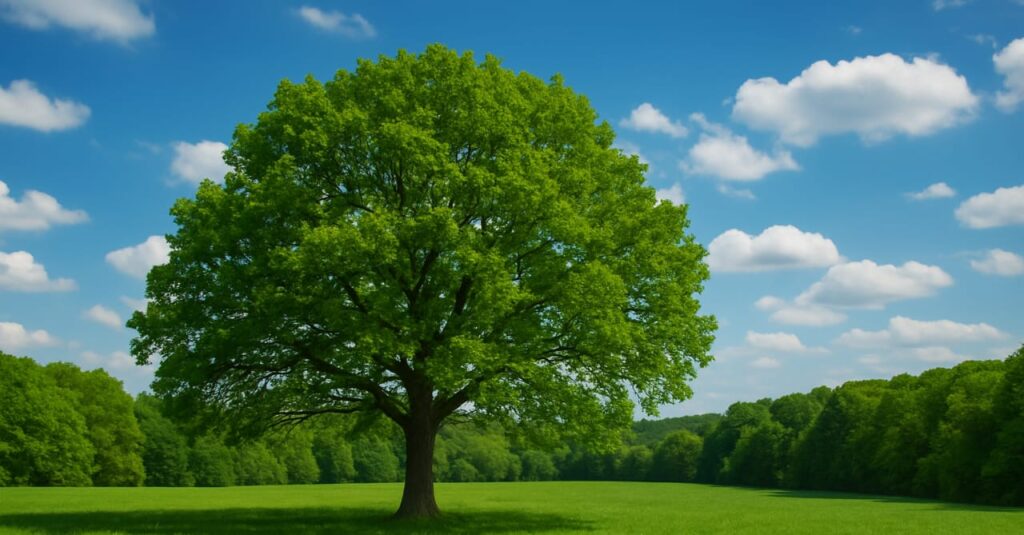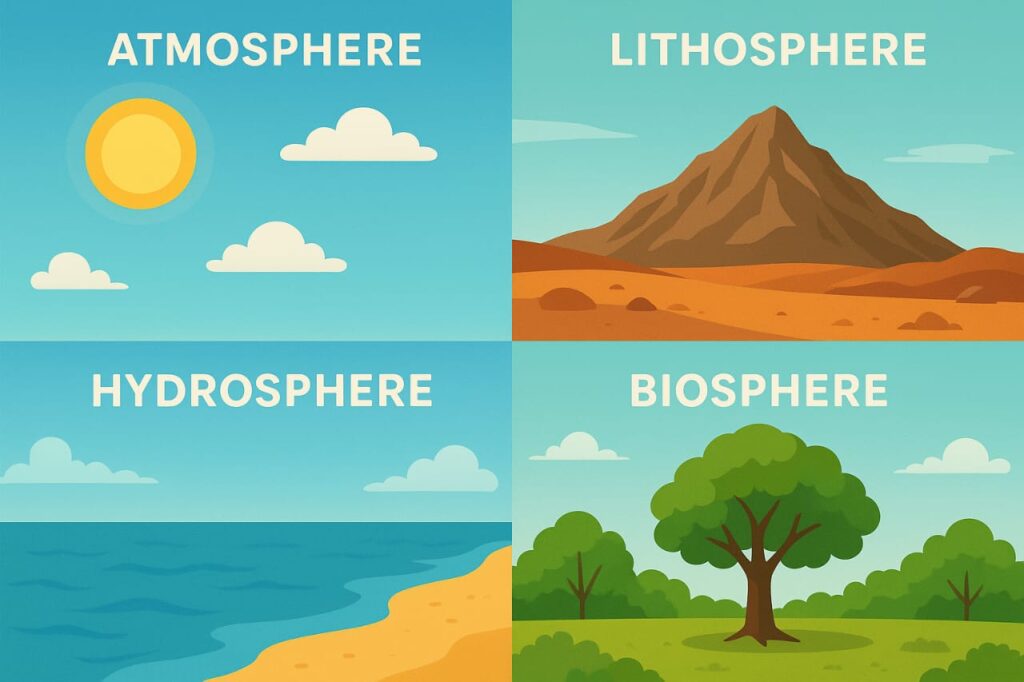Definition of Environment
According to sociologist P. Gisbert, “Environment is anything immediately surrounding an object and exerting a direct influence on it.”
In simple words, the environment refers to everything that surrounds us — both living and non-living things. It includes natural forces like air, water, soil, temperature, and living organisms that interact with one another. Every living being depends on its surroundings for food, shelter, and survival.
It can be described as the sum of all external conditions — physical, chemical, and biological — that affect the life and development of organisms. Survival and growth of all forms of life on Earth depend on the quality and balance of this environment.

Children’s Definition of Environment
1. The physical surroundings in which a person lives — for example, a peaceful rural area or a busy city.
2. The natural conditions such as soil, climate, and living organisms that influence the growth and survival of plants and animals.
Types of Environment
The environment can broadly be classified into three main types — Natural, Man-Made, and Human.
1. Natural Environment
The natural environment includes all living and non-living things that exist naturally on Earth. It covers the interaction between air, water, land, plants, and animals.
It is the original environment, free from human interference. Examples include forests, rivers, mountains, oceans, and wildlife.
In contrast, the built environment refers to areas modified or developed by humans such as buildings, roads, and cities. The term natural environment is also often used as a synonym for habitat.
2. Man-Made Environment
The man-made or artificial environment is created by humans to meet their needs. It includes things like buildings, roads, bridges, factories, and vehicles.
Humans modify the natural surroundings to make them suitable for living and development. While this has improved comfort and progress, it has also caused pollution and environmental damage.
It mainly focuses on the physical structures created by humans.
3. Human Environment
It has evolved from the natural one as humans adapted to their surroundings.
It includes social, cultural, economic, and political conditions created by humans. The development of agriculture, domestication of animals, trade, industry, and urbanization are all part of the human environment.
With technological progress, humans have become capable of transforming their environment to an even greater extent.
Components of Environment
It is made up of different interrelated components that work together to sustain life. These are:
1. Atmosphere
The atmosphere is the blanket of gases surrounding the Earth, such as oxygen, nitrogen, and carbon dioxide. It protects living beings from harmful solar radiation and helps regulate temperature.

2. Lithosphere
The lithosphere is the solid outer layer of the Earth consisting of rocks, mountains, minerals, and soil. It provides natural resources, including metals, fossil fuels, and fertile land for agriculture.
3. Hydrosphere
The hydrosphere includes all forms of water on Earth — oceans, rivers, lakes, groundwater, glaciers, and even moisture in the air. It is essential for the survival of all living organisms.
4. Biosphere
The biosphere is the zone of life on Earth where land, air, and water interact. It includes all living beings — plants, animals, and microorganisms.
Other Classifications of Environment
The environment can also be classified as:
Micro: The immediate surroundings of an organism, such as the air, soil, or water in a specific area.
Macro: The larger, external physical and biological conditions that influence life on Earth.
Physical: Non-living factors like temperature, light, rainfall, and minerals.
Biotic: All living things such as humans, animals, and plants.
Additionally, it can be viewed as Inner Environment (internal biological processes) and Outer Environment (external surroundings).
Importance of Environment

It is the foundation of life on Earth. It provides air, water, food, and shelter — all the essentials for survival. Beyond these basic needs, it plays several crucial roles:
1. Supports Life: All forms of life depend on the environment for their existence.
2. Maintains Ecological Balance: Natural elements like air, water, and soil interact to keep ecosystems stable.
3. Regulates Climate: Forests and oceans help control temperature and weather patterns.
4. Provides Natural Resources: Minerals, fuel, wood, and other materials come from the environment.
5. Ensures Mental and Physical Well-Being: A clean and green environment promotes health, peace, and happiness.
6. Source of Natural Beauty: Nature provides aesthetic and recreational value that enhances human life.
Without a healthy environment, life cannot sustain. Therefore, protecting it is a collective human responsibility.
Read About Afforestation
Why is Our Environment Changing?
It is rapidly changing mainly due to human activities. The major reasons include:
Global Warming: Excessive emission of greenhouse gases like carbon dioxide traps heat, increasing Earth’s temperature.
Deforestation: Large-scale cutting of trees reduces oxygen levels and disturbs wildlife habitats.
Pollution: Air, water, and soil pollution caused by industries, vehicles, and plastic waste lead to serious health hazards.
Depletion of the Ozone Layer: Harmful chemicals such as CFCs damage the ozone layer, allowing ultraviolet rays to reach the Earth.
Acid Rain: Pollution from factories and vehicles releases gases that mix with rainwater, harming crops and aquatic life.
Unbalanced Ecosystem: Overuse of natural resources disrupts the balance between living and non-living elements.
Decline in Rainfall: Environmental damage often results in irregular rainfall and climate change.
All these factors combined are leading to the degradation of our environment and threatening life on Earth.
Environment Protection

The Environment Protection Act of 1986 was introduced by the Government of India after the Bhopal Gas Tragedy to safeguard the environment. It came into effect on 19 November 1986 and contains 26 sections across four chapters.
This Act empowers the government to take necessary actions to prevent environmental pollution and improve environmental quality. It also aims to implement the decisions of the United Nations Conference on the Human Environment.
The Act serves as an umbrella legislation, coordinating activities under earlier laws like the Water Act and Air Act to ensure a comprehensive environmental framework.
Major Threats to the Environment
1. Overpopulation: Rising population increases demand for food, water, and land, leading to resource depletion and habitat loss.
2. Pollution: Industrialization and urbanization generate massive waste, contaminating air, water, and soil. Around 2.4 billion people still lack access to clean drinking water.
3. Global Warming: Burning fossil fuels increases CO₂ levels, raising Earth’s temperature and melting glaciers.
4. Deforestation: Forests are cleared for farming and urban expansion, causing loss of biodiversity and imbalance in carbon levels.
5. Excessive Use of Natural Resources: Overconsumption of minerals, fossil fuels, and wildlife products disrupts ecological balance.
6. Non-Vegetarian Diet Impact: Producing meat consumes far more grain and water than a vegetarian diet, placing stress on land and resources.
7. Luxury and Vanity Products: Items like leather, fur, and ivory cause animal cruelty and harm biodiversity.
Need for Environmental Protection
Protecting the environment is essential for sustaining life and ensuring a healthy future. We depend on natural systems for everything — from the oxygen we breathe to the water we drink.
Uncontrolled exploitation of resources will make the planet uninhabitable for future generations. Therefore, adopting sustainable practices like tree plantation, waste reduction, renewable energy, and eco-friendly products is the need of the hour.
Conclusion
Humans are both the creators and destroyers of their environment. Our actions have pushed nature to a critical point, but it’s still not too late to make a change.
Environmental protection laws are effective only when individuals take responsibility. Every person must contribute — by conserving energy, planting trees, avoiding plastic, and spreading awareness.
If we join hands and act together, we can restore balance and ensure a safe, clean, and sustainable Earth for ourselves and generations to come.
Let’s protect the environment — because our life depends on it.
Read About Atmosphere
